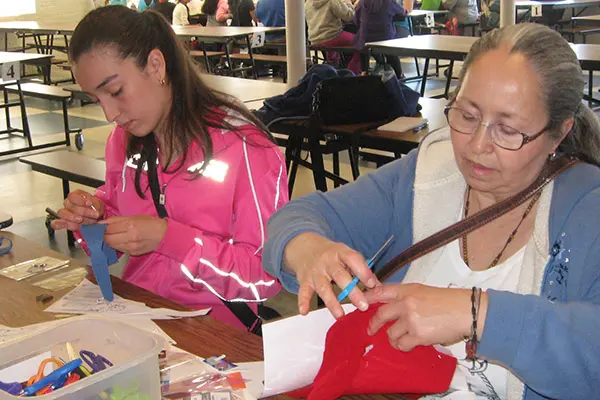Professor Hopes to Reduce Math Anxiety in Women
 Image by Katharine Webster
Image by Katharine Webster
09/02/2016
By Katharine Webster
Knit one, purl two, increase by one stitch, decrease by two.
As binge-knitters, beaders and quilters all know, most popular handcrafts involve math – and lots of girls and young women enjoy them.
That's why Psychology Prof. Sarah Kuhn, who suffered math anxiety herself as a child, thinks using textiles in the classroom could reduce math anxiety among girls and young women – and improve learning for everyone. Research has found that although the gender gap in math achievement is shrinking, it's still significant, partly due to girls' anxiety and lack of confidence.
"I want to know what role the fiber arts can play in attracting girls and other underrepresented groups to science, technology, engineering, mathematics and computing," says Kuhn, an associate of the university's Center for Women and Work and the Advancing Stem: Women in the Academy group who also researches the effects of computers on the workplace.
So Kuhn assembled a team of math, engineering and education professors, students and fiber artists to develop STEM lessons using textiles. The project, Lowell Tex, draws its name from North Campus's historical origins as the Lowell Textile Institute, then Lowell Technological Institute, and is funded by a Creative Economy Grant from the UMass President's Office.
 Image by Katharine Webster
Image by Katharine Webster
Last spring, Lowell Tex began piloting its lessons in classrooms at Lowell National Historical Park and on campus. At the park over spring break, middle-schoolers learned about circuits by making a paper bracelet with a circuit of copper tape, a tiny battery and the leads of an LED. When they closed the copper tape circuit with a "switch," the LED lit up. Next, they stitched a wearable version, using felt bracelets with a circuit of steel thread.
In Asst. Prof. Christopher Hansen's Materials Science for Engineers labs, students applied tensile force and shear stress to a grab-bag of textiles from knits to woven fabric, then measured how the fabrics stretched, deformed and buckled. The lesson was a hit.
"With fabrics, students can visualize the effects of shear and tensile stresses in a way that they can't with metals or other rigid materials," Hansen says. "Students were very excited. They'd dive into this bag and see what else they could test."
This fall, math major Brad Marshall '17 will try out a lesson on prime numbers, using yarn and circular knitting looms, with teenagers in an after-school program run by Lowell artist Diana Coluntino, founder and director of New Vestures, a shared workspace for fashion designers. Marshall also plans to guest-teach a lesson on modular arithmetic in an undergraduate Explorations in Mathematics class.
Marshall is in the UTeach program, which encourages STEM majors to become teachers. He says the craft-based lessons help him empathize with students who find math difficult. "When it comes to weaving or knitting, I'm a novice, so it puts me in the mindset of a student who's struggling," he says.
 Image by Katharine Webster
Image by Katharine Webster
Kuhn also bought a used 16-harness production loom that weaver and educator (https://www.linkedin.com/in/chriztine-foltz-55518814) Chriztine Foltz installed in the MakerSpace on North Campus. The loom is controlled with a binary peg system that allows the weaver to make binary math and complex intersecting planes visible in the fabric.
"Mathematically, we can create multiple layers of cloth or very fancy structures designed in the cloth. We can look at how planes bisect: On a 16-harness loom, you can have up to eight different layers of fabric, and you can bring one layer up above another layer," she says. "It's a way to work through a theory or an idea."
Foltz, who designs woven cables and fabrics for medical and military use, says the loom is also practical: UMass Lowell researchers and students can use it to test new design ideas for industrial and military "smart" fabrics. Starting this fall, Foltz will demonstrate the loom's possibilities to students and professors.
"We're opening up ways for old technology to be used in new directions," she says.
 Image by Chriztine Foltz
Image by Chriztine Foltz
Kuhn says that even though the 2015 Creative Economy Fund grant has almost run out, Lowell Tex is just getting started. She hopes to win funding for the group to create more textile-based lessons and to build on her research on math anxiety.
Kuhn has started a website and blog called "Thinking with Things" and piloted a class in fiber arts for engineers while on sabbatical at Olin College of Engineering. She also teaches classes on crocheting hyperbolic planes at New Vestures.
Her goal: to "turn education inside out" by creating more opportunities for hands-on learning. She's transformed a classroom in the basement of Coburn Hall into a small South Campus makerspace with colorful Tinkertoys, Lego and craft materials for use by faculty and students, including those in her Designing the Future World classes.
"Research shows us that kids learn very well with physical objects, but adults do too – that's the secret," she says. "I've started having students make things in many of my classes."



